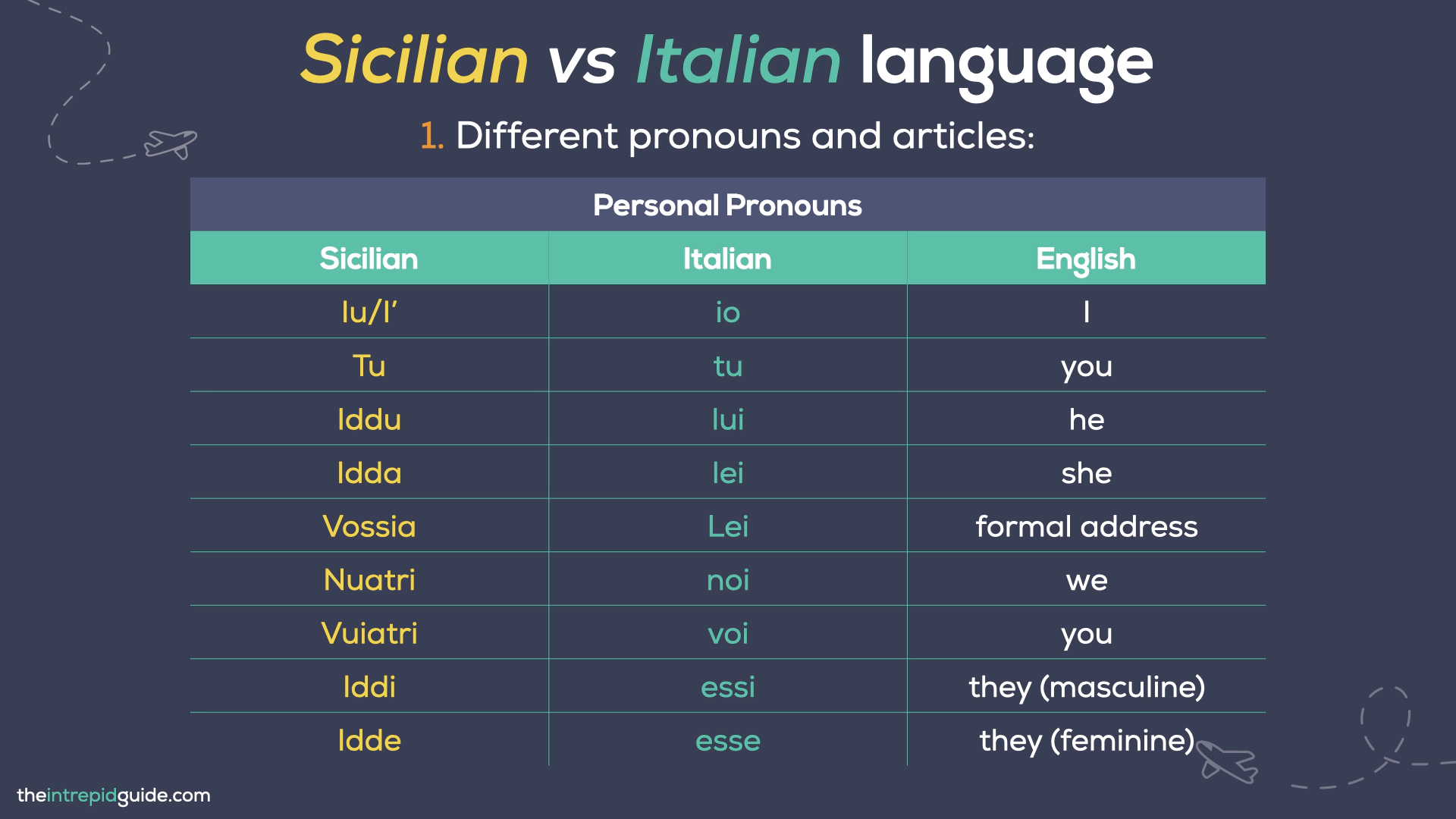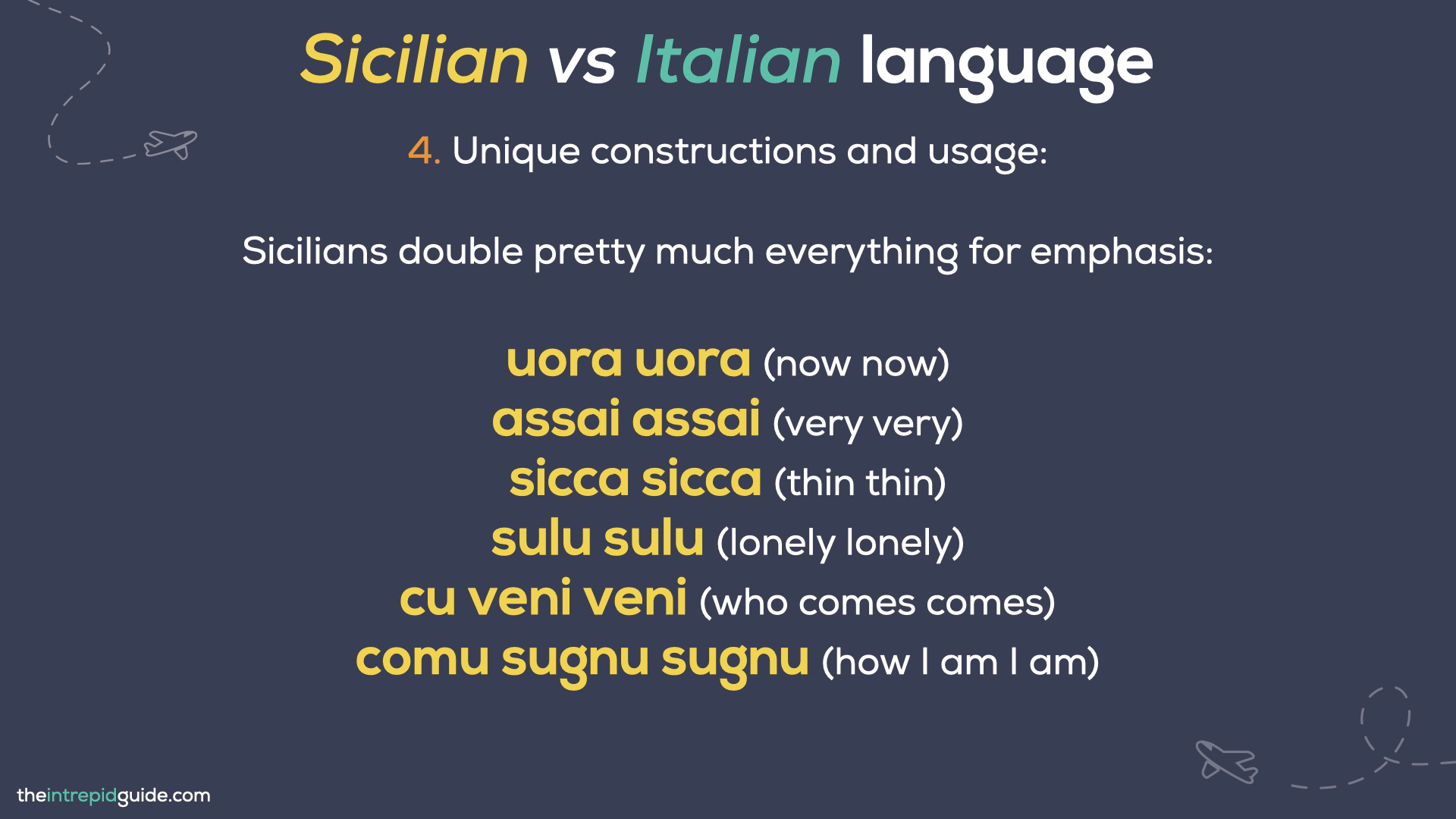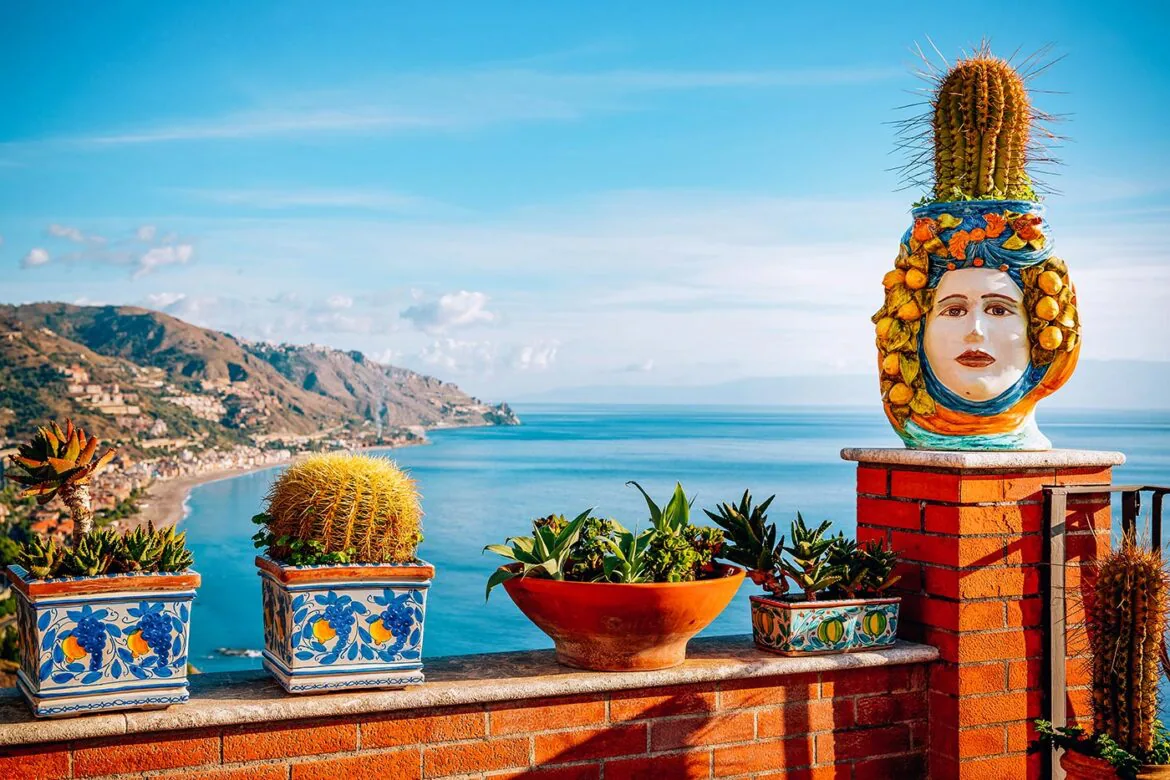From vocabulary, grammar, and pronunciation there are many differences between Italian and Sicilian. Even natives can misunderstand each other! Ah, bedda Sicilia! Wait… shouldn’t it be bella? Well, technically yes, bella is the Italian word for beautiful, but in Sicily, linguistic surprises await around every corner!
Don’t believe it? Try asking for directions in your polished Italian at one of Palermo’s bustling markets, and chances are you’ll get a colorful response sprinkled with exotic terms like accussì for “così” (so) and m’avi a scusare for “le chiedo scusa” (I beg your pardon).
Yep, that’s Sicily – a place where Italian meets a whole lot of local flavor! Because, let’s face it, while Italian might be the official language of the country, every region proudly boasts its own linguistic quirks. After all, Italy only became a unified nation in 1861 and before that, it was more like a patchwork of independent states, each representing a unique identity. And boy, does Sicily add some serious uniqueness to this mosaic!
What’s truly fascinating is that Sicilian isn’t just a simple dialect but a distinct language in its own right. Just consider that, according to UNESCO’s World Atlas of Languages, it boasts a staggering speaker base of some 10 million people worldwide! That’s a seriously impressive statistic that speaks volume about its significance and enduring cultural impact.
So, this guide is all about unveiling the main differences between Italian and Sicilian. We’ll start with some historical context, then explore the key linguistic distinctions, and enjoy some fun facts about food and culture along the way. So, ready for this linguistic adventure? Let’s dive in!
Table to Contents
Here’s what we’ll cover in this guide. Click on any title to jump to each section.
- Sicilian vs Italian: A brief history of two languages
- The difference between Italian and Sicilian
- Sicilian Food vs Italian Food
- Sicilian culture and traditions
Sicilian vs Italian: A brief history of two languages
 Italian and Sicilian both belong to the Romance language family, tracing their roots back to vulgar Latin. However, Sicilian is unique because it reflects the island’s intricate history, shaped by centuries of cultural exchange and foreign influences.
Italian and Sicilian both belong to the Romance language family, tracing their roots back to vulgar Latin. However, Sicilian is unique because it reflects the island’s intricate history, shaped by centuries of cultural exchange and foreign influences.
For more than three millennia, Sicily’s strategic position in the heart of the Mediterranean, coupled with its gorgeous landscapes and fertile land, attracted a myriad of civilizations. The Greeks were some of the earliest to leave their mark, setting up cities like Catania, Syracuse, and Taormina, along with grand temples and theaters.
Then came the Romans, who ran the show for about five centuries, turning Sicily into Rome’s granary, supplying the Roman Republic with large quantities of wheat through extensive agricultural exploitation. After them, a parade of peoples – Ostrogoths, Byzantines, Arabs, Normans, Spanish – each added their own flavor to the mix.
As you can guess, all these influences left their traces on the language. Sicilian soaked up words and phrases from these diverse populations, resulting in a linguistic heritage unrivaled by any other language. Just to give you a taste, here are some Sicilian words borrowed from other languages that are still used today:
- carusu (Italian: ragazzo – guy), from the Greek “kouros”
- cirasa (Italian: ciliegia – cherry) from the Greek “kerasos”
- a st’ùra (Italian: a quest’ora – at this time) from the Latin “ad istam horam”
- prescia (Italian: fretta – hurry) from the Latin “premere”
- abbanniari (Italian: gridare – to shout) from the German “bandujan”
- mischinu (Italian: poverino – unfortunate person) from the Arab “miskīn”
- giara (Italian: recipiente di terracotta per liquidi – jar) from the Arab “giarrah”
- sciarra (Italian: lite – argument) from the Arab “šarrah”
- armuaru (Italian: armadio – wardrobe) from the French “armoire”
- racìna (Italian: uva – grapes) from the French “raisin”
- buatta (Italian: barattolo – tin) from the French “boîte”
- curtigghiu (Italian: pettegolezzo – gossip) from the Spanish “cortijo”
- pignata (Italian: pentola – saucepan) from the Spanish “piñada”
- jurnàta (Italian: giornata – day) from the Spanish “jornada”
And here’s a fun fact: Sicilian actually helped shape the first Italian literary language. Back in the 13th century, during the time of Emperor Frederick II of Swabia, Sicily was home to the Sicilian School, a group of poets who were way ahead of their time. They introduced new literary techniques like the sonnet, which heavily influenced Western literature. Their work gained such widespread acclaim across Italy that even Dante, in his book “De vulgari eloquentia,” wrote: “[…] everything produced by the Italians in terms of poetry is called Sicilian […]”
The difference between Italian and Sicilian
 Sicilian and Italian indeed share some common grammatical features, such as the distinction between two genders (masculine and feminine), two numbers (singular and plural), definite and indefinite articles, and more. However, Sicilian has its own unique grammar, vocabulary, and way of speaking that sets it apart. It’s so distinct that the language coding agency SIL International has included Sicilian in a specific code denoting living languages. This means Sicilians could be considered bilingual in a way!
Sicilian and Italian indeed share some common grammatical features, such as the distinction between two genders (masculine and feminine), two numbers (singular and plural), definite and indefinite articles, and more. However, Sicilian has its own unique grammar, vocabulary, and way of speaking that sets it apart. It’s so distinct that the language coding agency SIL International has included Sicilian in a specific code denoting living languages. This means Sicilians could be considered bilingual in a way!
Now, don’t panic – Italian remains the official language spoken in Sicily, just like it is throughout Italy. You won’t find Sicilian taught in local schools; instead, people pick it up through everyday conversations. Despite this, Sicilian is still widely spoken on the island, especially in casual settings with friends and family. You might hear it more often in remote villages or among older generations, and sometimes it’s mixed with standard Italian, making it even trickier to understand. Even Italians themselves can find Sicilian challenging to grasp, so don’t be discouraged if you’re struggling.
Let’s take a closer look at some key differences that make Sicilian stand out:
1. Sicilian vs Italian: Pronouns and articles
Starting with the basics, Sicilian personal pronouns are different from their Italian counterparts:
- Iu/I’ (Italian: io – I)
- Tu (Italian: tu – you)
- Iddu (Italian: lui – he)
- Idda (Italian: lei – she)
- Vossia (Italian: Lei – formal address)
- Nuatri (Italian: noi – we)
- Vuiatri (Italian: voi – you)
- Iddi (Italian: essi – they)
- Idde (Italian: esse – they)

The definite articles in Sicilian are:
- u for “il” (the, masculine), as in u cavaddu (Italian: il cavallo – the horse)
- a for “la” (the, feminine), as in a mugghìera (Italian: la moglie – the wife)
- i for “i” and “le” (the, both masculine and feminine plural), as in i fimmini (Italian: le donne – the women)

The indefinite articles in Sicilian are:
- nu for “uno” (a, masculine), as in nu picciriddu (Italian: un bambino – a kid)
- na for “una” (a, feminine), as in na para di (Italian: un paio di – a pair of)

2. Sicilian vs Italian: Verb tenses and constructions
 Forget everything you thought you knew about verb tenses and constructions. Sicilians love using the remote past tense to talk about things that have already happened, whether it’s something light-years away from the present or an event just moments ago. For example:
Forget everything you thought you knew about verb tenses and constructions. Sicilians love using the remote past tense to talk about things that have already happened, whether it’s something light-years away from the present or an event just moments ago. For example:
- Mi manciai na persica uora uora (Italian: Mi mangiai una pesca ora ora – I’ve just eaten a peach)
- Vi lu dissi (Italian: Ve l’ho detto – I told you)
The future tense seems almost non-existent in Sicilian, what matters is the present. As the famous writer Sciascia once wrote, “How can you not be pessimistic in a country where the future tense doesn’t exist?” Hence, future actions are articulated using the present tense, often adding a time adverb to hint at when something is going to happen. For example:
- Cuannu finisciu i manciari nìesciu (Italian: Quando finirò di mangiare uscirò – When I finish eating, I will go out)
- Vegnu l’annu vinturu (Italian: Vengo l’anno prossimo – I’ll come next year)
The conditional tense finds itself relegated to the shadows, replaced by the subjunctive mood. Examples:
- Si putissi, u facissi (Italian: Se potessi, lo farei – if I could, I would do it)
- Si mi l’avissi dittu, ti l’avissi purtatu (Italian: Se me l’avessi detto, te l’avrei portato – If you had told me, I would have brought it to you)
The verb essiri (Italian: essere – to be) surrenders its auxiliary role to the verb aviri (Italian: avere – to have). Examples:
- Aju statu instead of sono stato (I have been)
- Aviti statu instead of sei stato (you have been)
And when it comes to saying “have to,” they swap out dovere (to have to) for avere (to have), as in:
- Aviti a travagghiari (Italian: Dovete lavorare – You have to work)
- Aju a stari cu tia (Italian: Devo stare con te – I have to stay with you)

3. Sicilian vs Italian: Pronunciation
Sicilian doesn’t follow the same rules as Italian pronunciation so it’s practically impossible to pronounce vowels and consonants the same way the Italian language does.
The vowels “e” and “o” are only pronounced open. Words ending with an -e in Italian change to an -i ending in Sicilian:
- mare (sea) > mari
- sole (sun) > suli
Words ending in -o in Italian take on a -u in Sicilian:
- uomo (man) > omu
- pozzo (well) > puzzu
The Italian syllables -glio, -glia, and -gli turn into -gghiu, -gghia, and -gghi in Sicilian:
- scoglio (cliff) > scogghiu
- sbrogliare (to unravel) > spirugghiari
- figli (sons) > figghi
Further differences between Italian and Sicilian can be found in the pronunciation of the following consonant clusters:
- “ng” becomes “nc” as in spìnciri (Italian: spingere – to push)
- “ns” becomes “nz” as in penzo (Italian: penso – I think)
- “nd” becomes a double “n” as in munnu (Italian: mondo – world)
- “tr” is pronounced similar to the “tr” sound in the English word “tree.”
The double ll turns into a double dd:
- cavallo (horse) > cavaddu
- bella (beautiful) > bedda
4. Sicilian vs Italian: Constructing sentences and usage
Drawing from Spanish, Sicilian uses the preposition “a” to introduce the animated direct object complement. This refers to a living being, whether a person or an animal, that represents the object of the action indicated by the transitive verb in a sentence:
- Vitti a Lucia for Ho visto Lucia (I saw Lucia)
- Salutai a to frati for Ho salutato tuo fratello – (I said hello to your brother)
The masculine form occasionally steps in for the feminine, and vice versa:
- Un negozio (a shop, masculine) > na putìa (feminine)
- Un’arancia (an orange, feminine) > un aranciu (masculine)
Sicilians are masters in the art of doubling. Seriously, they double pretty much everything for emphasis:
- adverbs, as in uora uora (now now) or assai assai (very very)
- adjectives, as in sicca sicca (thin thin) or sulu sulu (lonely lonely)
- verbs, as in cu veni veni (who comes comes) or comu sugnu sugnu (how I am I am)
5. Uniquely Sicilian idioms

Some Sicilian idiomatic expressions possess a distinct charm that often eludes straightforward translation:
- Futtitinni can be translated as “forget about it,” but its meaning hides a much more profound philosophy of embracing life lightly and forgetting about trivial matters.
- Camurria is usually translated as “annoyance,” but it doesn’t simply convey any irritation; it’s the exasperation that builds up when someone keeps getting on your nerves, turning into a real headache.
- Peri peri literally translates to “feet feet” and might seem nonsensical at first, but in Sicilian, it’s a playful way of saying “roaming around,” capturing that sense of wandering.
- Liscìa is all about lightness and laughter, capturing the joy of simply being alive and finding delight in the everyday. It’s like Sicilian sunshine in a word!
- Cataprasima is a word used to describe someone who seems to lack any spark of responsiveness or usefulness. There’s no neat translation for it in Italian; it’s uniquely Sicilian.
Sicilian food vs Italian food
 When you think of Italian food, the revered trio of pasta, pizza and tiramisù usually comes to mind, right? Well, the thing is, even if you’re well-versed in the delights of Italian cooking, Sicilian food will totally surprise you. Sure, both cuisines have tradition and diversity at their core, a range of delicious pasta dishes and some seriously good pizzas, but the island’s food is once again a melting pot of flavors from different cultures.
When you think of Italian food, the revered trio of pasta, pizza and tiramisù usually comes to mind, right? Well, the thing is, even if you’re well-versed in the delights of Italian cooking, Sicilian food will totally surprise you. Sure, both cuisines have tradition and diversity at their core, a range of delicious pasta dishes and some seriously good pizzas, but the island’s food is once again a melting pot of flavors from different cultures.
The Greeks introduced the island to wine, olive oil, and olives, laying the groundwork for Mediterranean flavors. The Romans contributed “garum”, a pungent fermented fish sauce, among other things, adding depth to Sicilian culinary creations. The Normans brought in smoked herrings and marzipan fruits. And let’s not forget Emperor Frederick II, who introduced the art of “scapece”, a preservation technique based on vinegar, which imparts a strong taste to many Sicilian fish and vegetable dishes.
However, it’s the Arab influence that is particularly intriguing. Not only did they introduce a range of ingredients that have become staples in Sicilian cooking – including citrus fruits, eggplants, pistachios, saffron, raisins, and couscous – but they also gifted the island with three culinary treasures: arancini (rice balls), cannoli (tube-shaped shells of fried pastry dough with a sweet ricotta filling), and pasta di mandorle (almond paste pastries).
Sicilian cuisine is also about celebrating its own unique bounty, as seen in the case of the “cucuzza,” the island’s elongated zucchini, and its tender leaves (called “tenerumi”), which are used in some delicious pasta dishes and soups. Another example is the finocchietto selvatico (wild fennel), which grows spontaneously in the Sicilian countryside and can be typically found in pasta with sardines.
Sicilian Culture and Traditions
 In the realm of culture, what generally holds significance in Italy is amplified in Sicily. Let’s take the concept of family, for example: while it carries substantial weight across all regions of Italy, in Sicily, familial bonds delve even deeper, with a strong sense of community and respect for elders. Likewise, while hospitality is a cherished concept throughout Italy, Sicilians are renowned for their exceptional mastery of it – it’s the calore siciliano (Sicilian warmth)!
In the realm of culture, what generally holds significance in Italy is amplified in Sicily. Let’s take the concept of family, for example: while it carries substantial weight across all regions of Italy, in Sicily, familial bonds delve even deeper, with a strong sense of community and respect for elders. Likewise, while hospitality is a cherished concept throughout Italy, Sicilians are renowned for their exceptional mastery of it – it’s the calore siciliano (Sicilian warmth)!
Popular devotion is another big deal on the island, with religiosity and local folklore being deeply ingrained in the daily lives of its inhabitants. Festivals, in particular, play a central role with multi-day celebrations and colorful processions in honor of saints, as in the case of the Feast of Sant’Agata in Catania and the Feast of Santa Rosalia in Palermo.
And let’s not forget about tradition. Sicily’s got its own set of unique customs, like the UNESCO-listed Opera dei Pupi (Puppet Opera), which is still a major part of Sicilian culture, staging tales steeped in the island’s rich history and identity. Or the colorful carretto siciliano (Sicilian cart), which was once used for transportation and work in the 19th century and has become a stunning piece of art because of its bright colors, sacred images, and captivating narratives.
Lastly, the role of time in Sicilian culture. Sicilians are very laid back. Lunch breaks are long, shops might close in the afternoon, and punctuality is often viewed with flexibility. It’s all about embracing a slower pace of life and enjoying the moment!
If you enjoyed this guide then you’ll love Intrepid Italian, my series of online self-paced video courses that break down everything you need to know about Italian using my 80/20 method. Visit IntrepidItalian.com for more details.
 Are you a beginner or an intermediate Italian learner? Got a trip coming up or want to communicate with your Italian partner or relatives in Italian? Learn Italian with my unique 80/20 method
Are you a beginner or an intermediate Italian learner? Got a trip coming up or want to communicate with your Italian partner or relatives in Italian? Learn Italian with my unique 80/20 method
Registrations are now open to join Intrepid Italian, my new series of online video courses that use my unique 80/20 method. You’ll go from a shy, confused beginner to a proficient and confident intermediate speaker, with me as your trusty guide.
You’ll finally be able to connect with your Italian partner, speak to your relatives and enjoy authentic travel experiences in Italy that you’ve always dreamed of, and so much more.
As a native English speaker who learned Italian as an adult, I know what it’s like to feel hopeless and lack the confidence to speak. I know what it’s like to start from scratch and to even go back to absolute basics and learn what a verb is!
Intrepid Italian was created with YOU in mind. I use my working knowledge of the English language to help you get into the ‘Italian mindset’ so you can avoid the common pitfalls and errors English speakers make – because I made them once too! I break everything down in such a way that it ‘clicks’ and just makes sense.
No matter what your level is, there is an Intrepid Italian course for you, including:
- 🇮🇹 Intrepid Italian for Beginners (A1)
- 🇮🇹 Intrepid Italian for Advanced Beginners (A2)
- 🇮🇹 Intrepid Italian for Intermediates (B1)
You can join 1, 2, or all 3 courses, it’s entirely up to you. The best part is that you have lifetime access so you learn anytime, anywhere and on any device.
As your guide, I walk you through each lesson, step-by-step, using my unique 80/20 method. My approach is different from traditional methods because I teach you the most important 20% of the language right from the beginning so you can start to speak straight away.
Each course includes video lessons, audio exercises, downloadable worksheets, bonus guides, a private support community, and lifetime access all designed to streamline your learning while having fun.
It even comes with my famous “Celebrate with a Spritz Guarantee”. After 30 days of using Intrepid Italian, if you don’t want to celebrate your new-found Italian skills with an Aperol Spritz, you don’t have to pay a penny! Cheers! 🥂
Join Intrepid Italian here and start learning today!
Ci vediamo lì! (See you there!)
Learning Italian? Check out these Italian language guides
- Italian for Beginners | How to Learn Italian in 3 Simple Steps
- TOP 100 Most Common Italian Words (Plus PDF Cheat-Sheet & Quiz)
- Italian Prepositions:The Only Guide You’ll Ever Need (PLUS Chart)
- 17 Weird Italian Superstitions Italians ACTUALLY Live By
- 17 Must-Know Italian Hand Gestures: The Ultimate Guide
- 10 Ways Natives REALLY Say ‘You’re Welcome’ in Italian
- How to say ‘Please’ in Italian in 9 Ways Like a Native
- 41 Italian Greetings: How to Say ‘Hello’ in Italian Like a Local
- 125 Most Common Italian Phrases for Travel You’ll Ever Need [PLUS Printable]
- 8 DEADLY mistakes in Italian (& How to Avoid Them)
- How to Conjugate Italian Verbs in 3 Simple Steps [Italian for Beginners]
- Is Italian Hard to Learn? 7 Common Mistakes & How to Avoid Them
- Master Days of the Week in Italian (7 Simple Memory Hacks)
- Italian Numbers: How to Count in Italian From 0 to 1 Billion (Plus PDF Download)
- How to Order Food & Drinks in Italian [Italian for Beginners]
- 15 Italian Words You Should NEVER Mispronounce [& How Not To]
- 11 Effective Hacks That’ll Help You Learn Italian So Much Faster
- Top 14 Italian Words You Should NEVER Say [& What to Use Instead]
- 20 Hilarious Everyday Italian Expressions You Should Use
- Romanesco: 25 Cool Roman Dialect Words You Should Use in Rome
- 10 Reasons Why Learning Italian Will Change Your Life
- 10 Italian Expressions Italians Love Saying
- 10 Italian Phrases That Will Instantly Make You Sound more Italian
- Funny Italian Sayings: 26 Food-Related Insults You Won’t Forget
- 15 Romantic Italian Films That’ll Make You Love Italy Even More
- How to Master Common Italian Phrases for Travel (Like a Local!)
Like it? Pin it for later!

Over to you!
Did you enjoy this guide? Do you have a question? Let me know using the comments section below or join me on social media @intrepidguide or @intrepiditalian to start a conversation.
Thanks for reading and I hope you enjoyed this post.
Like what you see? Subscribe using the form below to have all of my posts delivered directly to your email.

